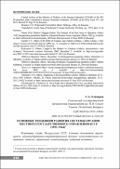Показать сокращенную информацию
Основные тенденции развития системы органов местного государственного управления БССР (1953-1964)
| dc.contributor.author | Елизаров, С. А. | |
| dc.coverage.spatial | Смоленск | ru_RU |
| dc.date.accessioned | 2024-03-18T10:34:31Z | |
| dc.date.available | 2024-03-18T10:34:31Z | |
| dc.date.issued | 2023 | |
| dc.identifier.citation | Елизаров, С. А. Основные тенденции развития системы органов местного государственного управления БССР (1953-1964) / С. А. Елизаров // Известия Смоленского государственного университета. – 2023. – № 1(61). – С. 218-232. | ru_RU |
| dc.identifier.uri | https://elib.gstu.by/handle/220612/31628 | |
| dc.description.abstract | В статье рассматриваются основные направления реорганизации структуры исполкомов Советов депутатов трудящихся - местных органов государственного управления БССР, расширения их материально-финансовой базы, новые тенденции в кадровой номенклатурной практике в 1953-1964 годах. Отмечается, что партийно-государственная политика относительно роли органов местного государственного управления в 1953-1964 годах в целом носила обновленный характер. Решающей становится инициированная высшим союзным руководством линия на сокращение административно-управленческого аппарата и расходов на его содержание, которая реализуется путем укрупнения как административно-территориальных единиц, так и структурных подразделений исполкомов. Центральным союзным органам принадлежала и инициатива расширения прав местных Советов и их исполкомов по формированию материально-финансовой базы своей деятельности. В номенклатурной кадровой работе происходит перераспределение сверху вниз сфер номенклатурной ответственности. Высшее образование становится необходимым атрибутом занятия руководящих должностей районного и областного уровней. Значительно возрастает степень мобильности руководящих кадров исполкомов Советов. | ru_RU |
| dc.description.abstract | The article discusses the main directions in reorganizing the structure of the executive committees of the Soviets of Workers' Deputies – local government bodies of the BSSR, expansion of their material and financial base, new trends in personnel nomenclature practice in 1953–1964. It is noted that the party-state policy regarding the role of local government bodies in 1953–1964 was generally updated. The line initiated by the supreme Union leadership to reduce the administrative and administrative apparatus and its maintenance costs, which is implemented through both the consolidation of administrative-territorial units and structural divisions of executive committees, becomes decisive. The central Union bodies also took the initiative to expand the rights of local Soviets and their executive committees to form the material and financial base of their activities. In nomenclature personnel work, the spheres of nomenclature responsibility are redistributed from top to bottom. Higher education becomes a necessary attribute of holding senior positions at the district and regional levels. The degree of mobility of the executive staff of the executive committees of the Soviets is significantly increasing. | |
| dc.language.iso | ru | ru_RU |
| dc.publisher | Смоленский государственный университет | ru_RU |
| dc.subject | Byelorussian SSR | ru_RU |
| dc.subject | Soviets of Workers' Deputies | ru_RU |
| dc.subject | Administrative-territorial division | ru_RU |
| dc.subject | Executive committees | ru_RU |
| dc.subject | Departments | ru_RU |
| dc.subject | Administrations | ru_RU |
| dc.subject | Nomenclature | ru_RU |
| dc.subject | Personnel policy | ru_RU |
| dc.subject | Белорусская ССР | ru_RU |
| dc.subject | Советы депутатов трудящихся | ru_RU |
| dc.subject | Административно-территориальное деление | ru_RU |
| dc.subject | Исполнительные комитеты | ru_RU |
| dc.subject | Номенклатура | ru_RU |
| dc.subject | Кадровая политика | ru_RU |
| dc.title | Основные тенденции развития системы органов местного государственного управления БССР (1953-1964) | ru_RU |
| dc.title.alternative | The Main Trends in the Development of the System of Local Government Bodies of the BSSR (1953–1964) | ru_RU |
| dc.type | Article | ru_RU |
| dc.identifier.udc | 94(476)«1953–1964» | |
| local.identifier.doi | 10.35785/2072-9464-2023-61-1-218-232 |
